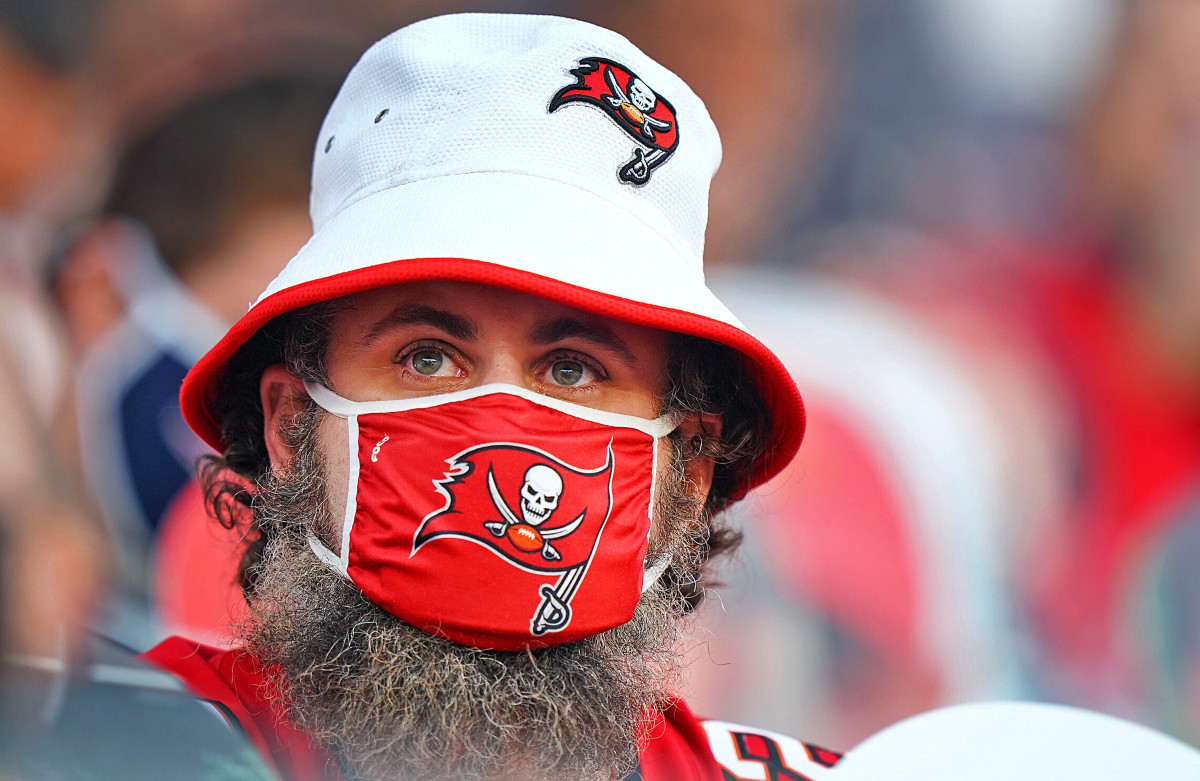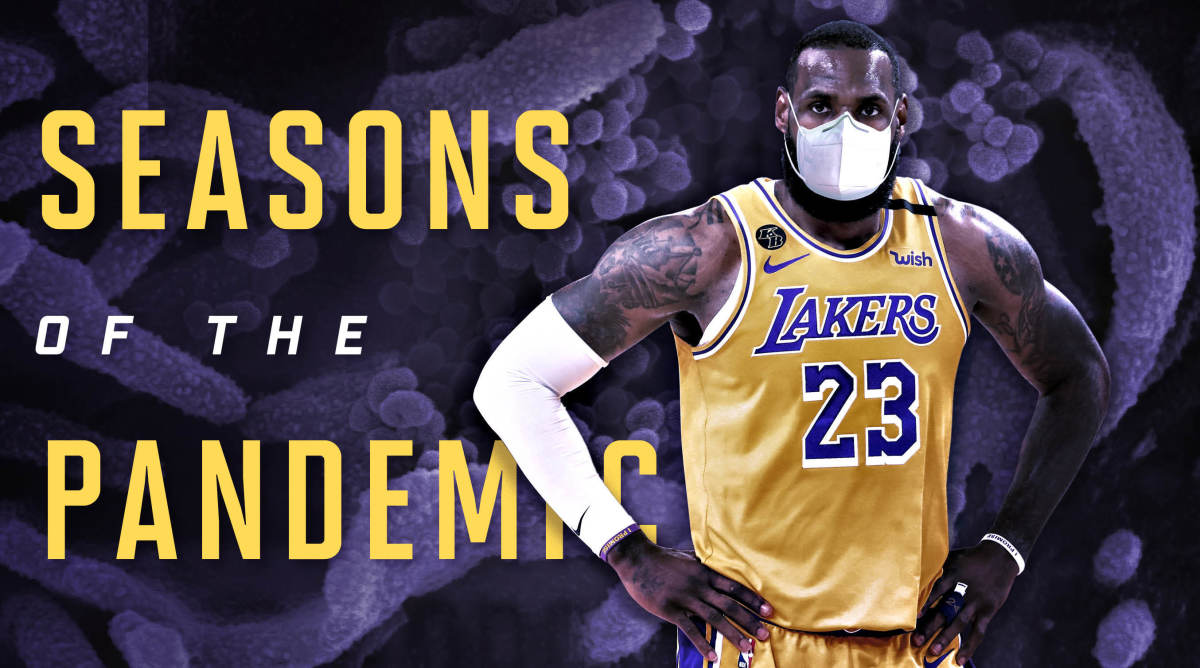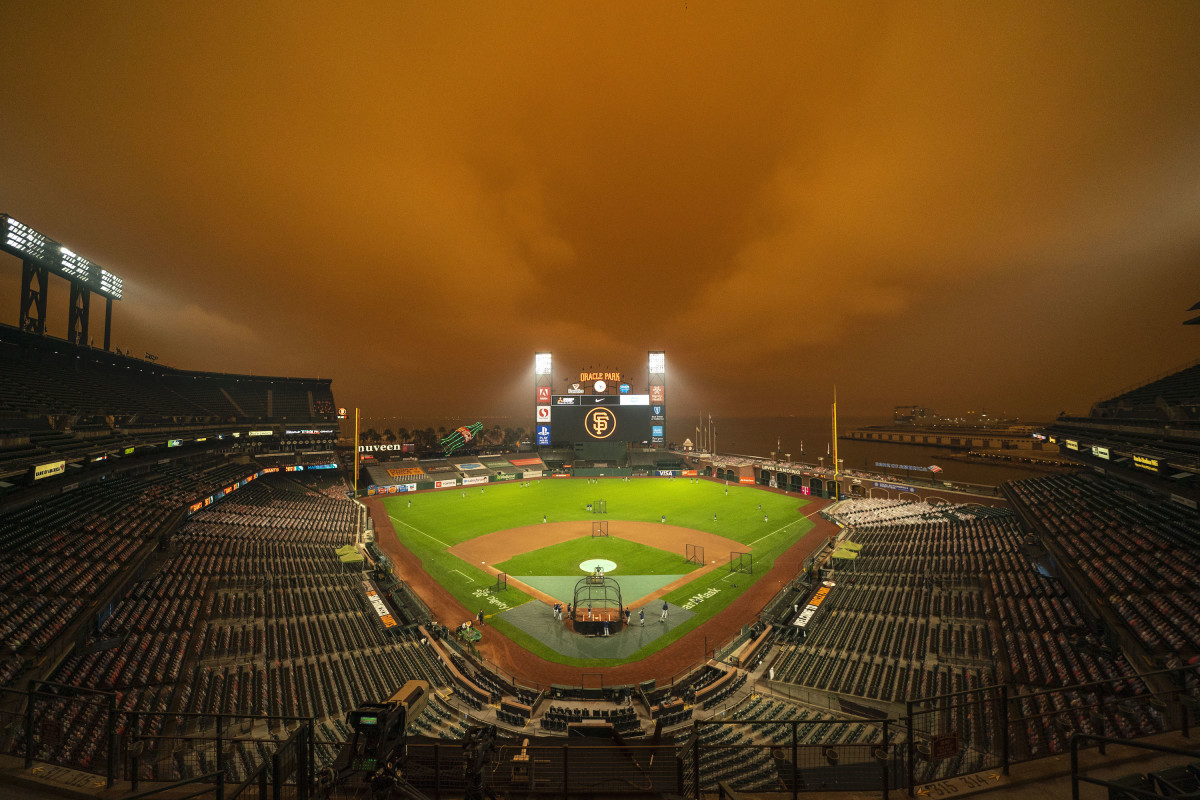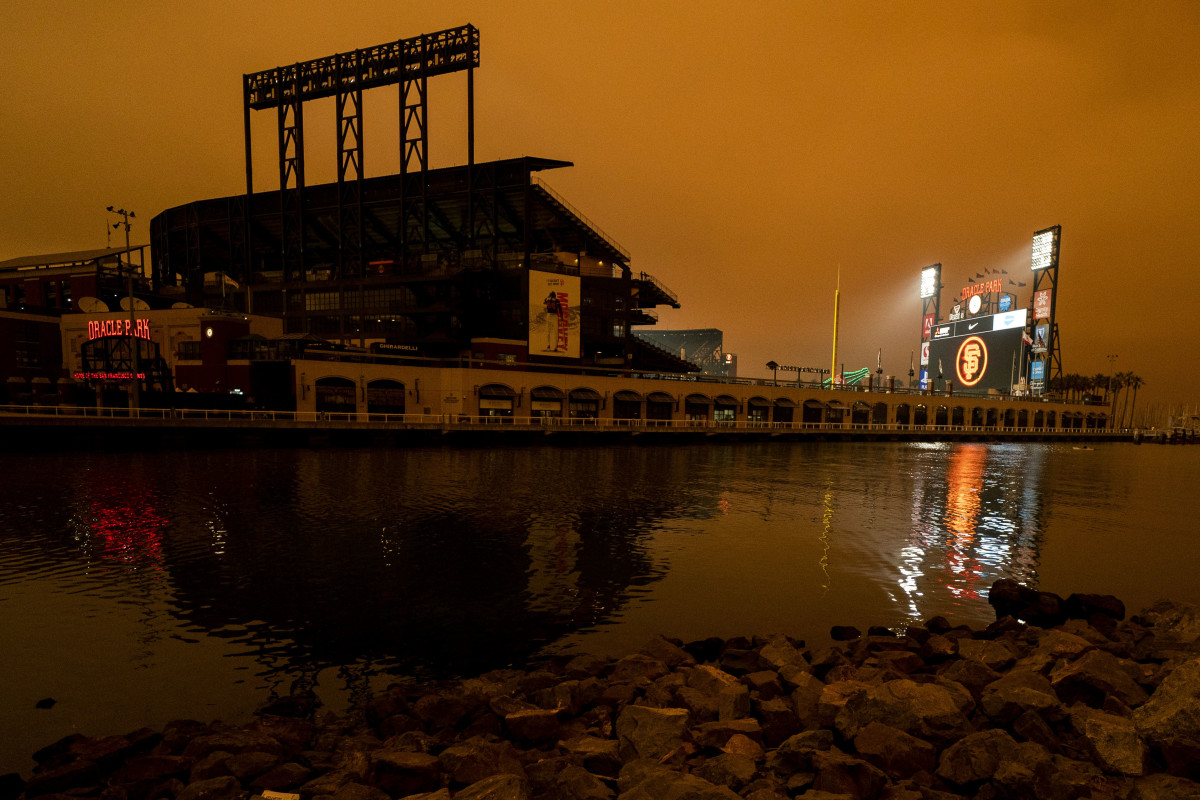How Sports Helped Americans Grasp the Severity of the Pandemic
On March 8 of last year, I sent the worst tweet in my life. “You: applying hand sanitizer every 10 minutes,” it read. “Me: [a photo of myself lounging on a beach chair, holding a can of Corona with the Caribbean Sea in the background].”
Like Ted Cruz, I know all about taking an ill-advised trip to Cancún. I left New York on March 6, two days after Sports Illustrated employees were notified that a person who worked for another company in our office building had tested positive for the coronavirus. I remember joking with a coworker before I left that I wouldn’t be too mad if I wasn’t allowed back in the country. The virus seemed like something to be mildly concerned about. After all, cases in the U.S. still numbered in the double digits at the time. (Well, the official number of cases confirmed by positive tests; researchers later concluded that millions of other cases had gone undetected due to testing shortfalls.)
My last full day in Cancún was March 9, the day Rudy Gobert made light of the virus by rubbing his hands all over reporters’ microphones. It was easy to see at the time that Gobert’s stunt was ignorant, but it was impossible to tell just how dangerous it was until two days later when his positive coronavirus test precipitated the shutdown of the NBA season.
For many Americans, March 11, 2020, was the day the pandemic suddenly became real. More specifically, it was between 8:30 and 9:30 p.m. ET that night. (It was also the day the World Health Organization officially declared the coronavirus outbreak to be a pandemic.)
At about 8:38 p.m. ET, the Thunder’s public address announcer informed the fans inside Chesapeake Energy Arena that the night’s game was postponed. At 9:27, The Athletic’s Shams Charania reported that Gobert had tested positive. Five minutes later, the NBA announced that the season was being suspended until further notice.
It wasn’t just sports fans who had sudden moments of clarity. Tom Hanks announced in an Instagram post at 9:08 p.m. ET that he and his wife, Rita Wilson, had tested positive. In a survey conducted by a Penn State professor the next day, about half of respondents said Hanks’s positive test changed their attitude about the virus.
What the NBA suspension and the Hanks positive test laid bare was what would become all too clear over the next 12 months. Being rich and famous couldn’t (entirely) protect you from getting sick and, more importantly, the simple “safety” precautions the NBA had enacted in early March (restricting media access to locker rooms, planning for games without fans and encouraging fist bumps over high fives) were woefully inadequate. This was not going to be a minor inconvenience. This was going to grind life as we knew it to a total halt..
The NBA had the important distinction of being among the first major entertainment businesses to announce it was shutting down. The NHL and NCAA followed suit one day later, while production on some TV series continued for a few more days. For anyone used to settling on the couch in front of the TV for a night flipping between games, the absence of live sports was a jarring indication of the severity of the emerging crisis. It was just one way in which life’s typical rhythm had been disrupted.
The return of the NHL and NBA also helped contextualize the kind of bold action needed to safely get society back on track. Abundant hand sanitizer in the locker room wasn’t going to cut it. Both leagues needed to lay out complex plans for “bubble” environments in an attempt to keep the virus at bay, similar to how restaurants constructed elaborate outdoor dining apparatuses and retailers retooled their businesses to prioritize curbside pickup.
Sports have been a useful bellwether throughout the entire pandemic. The attitudes of teams and leagues have (generally) mirrored those of the American public. In those early days last March, the changes made by leagues were severe—a total shutdown. But as cases fell in the summer and fall, society began to open back up. People were allowed to eat in restaurants, to walk through museums and sit in theaters. In locales with less cautious government leaders, they were allowed to attend football games—even indoors.
When infection rates rose again in the fall and winter, the sight of fans filling stands—in many instances failing to properly follow mask requirements—was enough to give a person hives. COVID-19 outbreaks ripped through teams like the Titans and Ravens. College football and basketball teams saw their schedules upended by positive tests. (The men’s basketball team at Iona played only 13 games in the regular season because it had two separate outbreaks.) The number of positive tests nationwide was even higher in the fall and winter than in the spring, but governments did not revert to the stringent restrictions of the early pandemic, and sports leagues did not hit the pause button—even though perhaps they should have.

SI’s Stephanie Apstein put it best when she wrote in June, “Sports are a treat you get when you live in a functioning society.” (A line that went viral when then Nationals reliever Sean Doolittle repeated it a week later.) “We do not live in a functioning society,” she continued. “We live in a society in which more than 118,000 people have died of COVID-19, the curves are pointed upward … and states are responding by reopening.”
Six months later, the situation wasn’t any better. A surge in cases driven by gatherings during the winter holidays pushed death tolls to daily records just as the NBA was beginning its season and the NFL playoffs started. Society was not functioning any better that it had been when Apstein wrote those words—not in any meaningful sense, at least. Thousands of people were still dying every day. Hospitals were still overwhelmed. But governments did not issue lockdown orders, and sports kept on rolling. Society had determined how much dysfunction it could tolerate.
In the coming months, sports will again be a measuring stick for the state of the pandemic. If all goes according to plan, as vaccines are distributed, fewer people will be sickened—that includes people associated with our favorite teams. Fewer games will have to be postponed. More fans will be allowed in the stands, and more fans will feel comfortable being in group settings. Their cheers will be robust enough that broadcasters can turn off the canned crowd noise. Anybody not lucky enough to be at the stadium can watch something they haven’t seen on TV in more than a year: a (pretty much) normal sporting event. It’ll feel as good as sipping a beer poolside on a sunny day in Cancún.

Read More Stories On the Year of the Shutdown
Trying to think about one year of pandemic living is a harrowing task, so perhaps it’s best to approach it like this: here are six things from the past 12 months that exemplified the life of a sports fan during the pandemic.
Athletes are just like us
When gyms shut down, people scrambled to find new ways to stay active. They improvised. A British man ran a full marathon in his tiny backyard—26.2 miles, 20 feet at a time. Pro athletes were no different. They had to find new ways to do the things they’d become accustomed to, with mixed results. Who could forget the time Tom Brady, unable to meet at his team’s offices, went to see Byron Leftwich and walked into the wrong house? Or when Jimmy Butler, confined to his hotel room during his mandatory quarantine inside the NBA bubble, got in trouble for incessantly dribbling a basketball?
Dodgers pitcher Joe Kelly set up a backstop in his yard—and broke a window when he missed his target.
An Olympic skier tried to stay limber by setting up an elaborate obstacle course in his living room.
Stephen Curry even had to build his own basketball hoop in his driveway just to get some shots up. The pandemic really did knock everyone down a few notches.
WWE, minus the spectacle
While non-scripted sports shut down in the days following March 11, WWE kept chugging along. With restrictions on public gatherings, the company moved its shows to its Orlando training facility, the WWE Performance Center, where Raw and SmackDown were filmed in an empty room. Because there was nobody watching live, performers even stopped wrestling during commercial breaks.
The results were … unsettling. It was bizarre to see the inherently over-the-top world of pro wrestling stripped down to its barest elements. When Adam “Edge” Copeland (who carved out a decent acting career during his nine-year hiatus from wrestling) cut a promo on Randy Orton, it felt very theatrical—not in the showy sense, but rather in that it felt like something you might see at an off-Broadway play.
It was even stranger to see “Stone Cold” Steve Austin, a man who can pop the crowd like nobody else, work in front of an empty room.
The scene was indicative of the difficulty everyone had navigating the new normal. In the months that followed, WWE and other wrestling companies figured out ways to present their product in interesting and entertaining ways without the benefit of thousands of screaming fans. But in those first few days, everything felt unnatural and improvised because, well, it was.
Baseball goes on as fires rage across the West Coast
The pandemic has been the overarching, unrelenting crisis of the past 12 months, but it has also at times overlapped with other crises: attacks on democracy in the winter, acute focus on police brutality and racial injustice in the early summer and, in the late summer, the destructive, deadly effects of climate change.
The 2020 wildfire season set records for most acres burned in California and Oregon. Washington saw the second most acres burned. And make no mistake, climate change is likely responsible for the record-setting blazes.
The fires began putting heat on the sports world as they encroached on multiple large West Coast cities. In late August, the Giants and A’s said they were monitoring the air quality forecast to determine whether it would be safe to play outdoors as smoke from nearby wildfires choked the air. (The air quality was “unsafe for sensitive groups” but not, apparently, for baseball players.) In September, the Mariners’ series against the Giants scheduled to be played in Seattle had to be postponed and eventually relocated because wildfires had made the air unsuitable for outdoor activities. Oakland pitcher Jesús Luzardo complained that he was “gasping for air” in their series finale in Seattle. And where were the games moved to? To San Francisco, where the sky looked like this:

Conditions were similar across the bay in Oakland, where the A’s played the Astros.
The result was an unsettling confluence of two things that made 2020 the most challenging year of West Coast residents’ lives. Baseball games were played under a dome of hellfire, in front of tens of thousands of empty chairs because a plague kept fans home.
In 20 years we’ll look back on images like this with horror. But in the moment, it was just one more awful aspect of a rotten year.

The Mavs threw a quarantine dance party
2020 was a year defined by finding ways to make the most out of difficult situations. Our normal lives had been ripped from us, but through sheer human ingenuity, people were able to find safe ways to produce passable facsimiles of usual activities.
Give the Mavericks credit for spending part of their mandatory quarantine time inside the NBA bubble turning their hotel room balconies into a club.
Think of all the sports moments that have been cheapened by the pandemic
Every sports fan is keenly aware of how, for 12 months, we’ve been deprived of full stadiums reacting in the heat of the moment to spectacular plays. But what about the smaller moments?
One such thing that I find myself thinking about every so often is this clip of Phillies prospect Logan O’Hoppe. The then 20-year-old catcher grew up on Long Island as a Yankees fan and got to put on a Phillies uniform for an exhibition game at Yankee Stadium last summer. It was easy to tell how much it meant to him.
Logan O'Hoppe is a 20-year-old lifelong Yankees fan who is getting to play at Yankee Stadium for the first time as part of this exhibition game. He's also trying his hardest not to break into song and dance at the plate. pic.twitter.com/myKViiq5eN
— Hannah Keyser (@HannahRKeyser) July 21, 2020
But it’s tough not to think about how much more special it would have been if we’d lived in a world where there could responsibly have been fans in the stands.
Fans pack stands in New Zealand in June
The sight of sold-out rugby stadiums in New Zealand in June filled me with the most confounding combination of emotions. Here in the United States, the virus was obviously nowhere near being contained and, frustratingly, states like Texas and Florida had started to repeal restrictions with no scientific basis for doing so. (Texas governor Greg Abbott reversed course in July and instituted a statewide mask mandate in response to overloaded hospitals. He recently...reversed course again and repealed that mandate.)
New Zealand, on the other hand, had successfully stopped the spread of the virus. By the time Super Rugby Aotearoa games welcomed fans on the weekend of June 13, the country had not seen a single case in three weeks. The Blues and Hurricanes played at Auckland’s Eden Park in front of 43,000 unmasked fans. Another 20,000 caught Highlanders vs. Chiefs in Dunedin.
The number of fans in the stands at Eden Park was nearly identical to the number of positive COVID-19 tests the United States reported (43,878) on the weekend the games were played. The highlights, which had honest-to-god crowd noise, felt like something from a science-fiction movie.
There must be a word in German for the combination of the sense of longing a sports fan feels seeing a packed stadium and the feeling of impotent rage inspired by knowing it’s possible for a country to control the pandemic.
